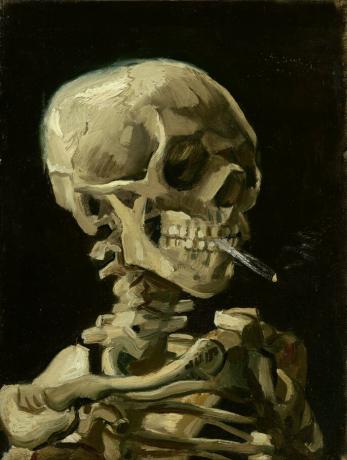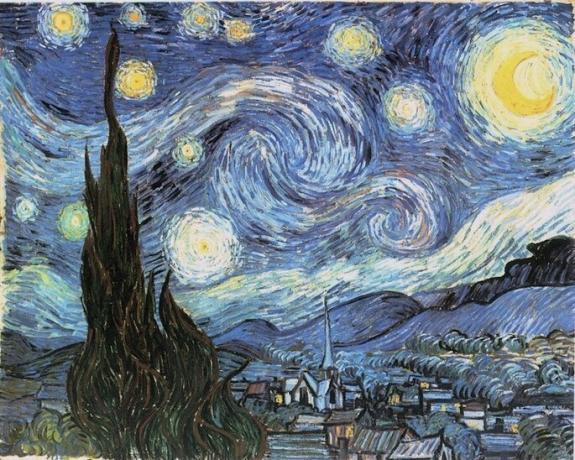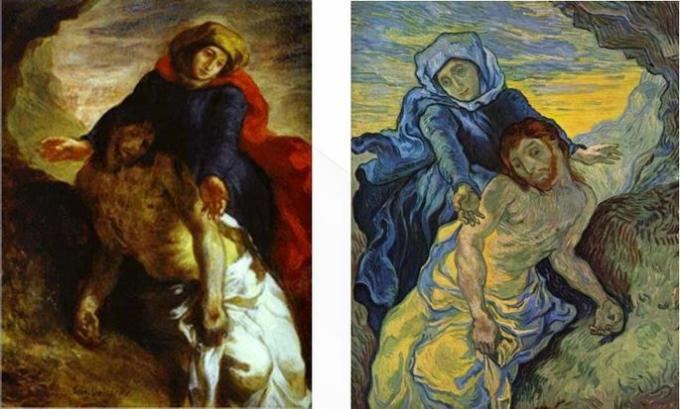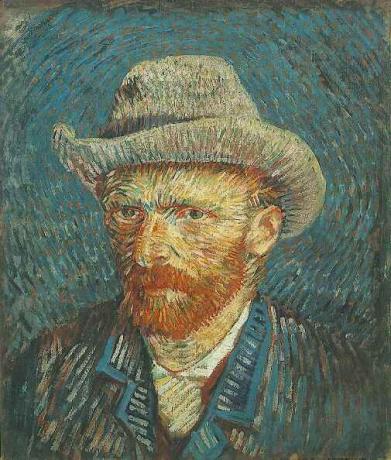Vincent van Gogh: 16 Genius Paintings Analyzed and Explained
Vincent van Gogh (1853-1890) is a Dutch painter who, together with Gauguin, Cézanne and Matisse, is considered a fundamental figure of the postimpressionism. Ahead of his time, during his life he never knew artistic success.
After his death, a retrospective exhibition in 1890 put him in the public eye. Since then, he has become one of the most influential artists in contemporary art.
Let's get to know some of his most important works and also discover the evolution of his artistic line.
The potato eaters, 1885

Accustomed as we are to the popular colorful paintings by Van Gogh, The Potato Eaters surprises us. With an earthy and almost baroque palette, Van Gogh depicts the scene of a peasant family sharing potatoes that they themselves have grown for dinner. He has done what the previous artists did not do: he has “removed make-up” from the characters, he has shown them in their rudeness and in their difference.
With this he has said no to the bourgeois gaze that conforms to picturesqueism so as not to take charge of the social gap. This painting corresponds to the first stage of the painter, which some call the black stage, which took place during his stay in Nuenen.
Skull with burning cigarette, 1885-1886

A key of humor is hidden in this canvas within a dark and earthy atmosphere, with a palette similar to the first canvas on this list. A skeleton wears a mockingly lit cigarette between its teeth. The forms are achieved through thick and rough brushstrokes that give the representation an expressive character.
Japonaiserie: Bridge in the Rain (after Hiroshige), 1887

Japanese art greatly influenced the art movements of the 19th century, so much so that, in 1872, Jules Claretie coined the term japonism in his book L'Art Francais to identify this trend turned into a true source of creativity.
Vincent van Gogh devoted himself to studying, copying, and versioning the most emblematic works of Japanese art, which he considered to be provided with compositional simplicity and expressive capacity at the same time. An admirer of Utagawa Hiroshige, Van Gogh developed this version of The Ohashi Bridge in Atake in a Sudden Rain.
The bedroom, 1888-1889

In the work The bedroom Van Gogh begins to show the style by which we know him best. Leaving behind the pictorial stage lived in Nuenen and installed in Arles, the painter begins to rethink color from a symbolic approach. Unfortunately, during a flood the original painting suffered some damage, which motivated the painter to make the second version. He would then make a smaller one for his mother and his sister Wilhemina.
According to his own words expressed in a letter to his brother Theo of his, Van Gogh wanted to express in his painting the tranquility and repose of an austere room. It combines the notion of Western perspective with the absence of volume in objects of Japanese art.
The sower, 1888

The theme of the sower is recurrent in Van Gogh's work, perhaps because of his sensitivity to peasant life, perhaps because of his Christian sensitivity (reminiscent of the parable of the sower). Although his intention is not clear to us, the truth is that in this painting Van Gogh is once again inspired, on the one hand, by the French painter Millet; on the other, in Japanese art, especially with regard to vegetation.
Inside the canvas, the treatment of the solar disk stands out, in which the brushstrokes are concentric, a unique line of the painter. Van Gogh paints the scene from memory under the motivation received by his then friend, Gauguin.
The red vineyard, 1888

Van Gogh represents a vintage scene with great realism. His line is thick and exposed. The human figures are highlighted with duly delimited contours. The nervousness of the line gives texture to the fields, which lie in a reddish autumn light. The sun, again, repeats the concentric brushstrokes.
This was the only painting ever sold by Van Gogh, other than to his brother Theo of his. It was acquired by Anne Boch, Eugène Boch's sister.
Portrait Postman Joseph Roulin, 1888

The postman Joseph Roulin conversed frequently with Van Gogh, who corresponded regularly with his brother Theo and Emile Bernard. The painting stands out for the use of the technique known as cloisonism, in which flat colors, such as the blue of the postman's suit, are closed with defined and obvious contours.
Different luck runs the face and, in particular, the beard, which has been resolved by means of small brushstrokes that create an almost wooded effect. The result of legs and hands at the drawing level is certainly strange.
Cafe terrace at night, 1888

Van Gogh creates a contrasting atmosphere with two environments: the yellow and bright brown, and the expectant night that opens at the end of the street. Thus, yellow and blue dominate the scene as perfect complements. In the sky, the stars like artificial lamps announce what will become the style found in The starry Night. The paving is achieved with curved lines that resemble scales. In the middle of the gloom, this vibrant and fuzzy café claims a share of joy.
Sunflowers, 1888-1889

All the pictures were painted in oil on canvas.
Sunflowers were a highly developed motif in Vincent van Gogh's painting. He did many versions. In each one of them, Van Gogh manages to transmit a great expressive force through resources such as vibrant color, nervous lines, the chaos of the petals and the use of light. He will make groups with three, with five, with twelve and even with fifteen flowers.
The starry Night, 1889

This is, without a doubt, the most emblematic painting of the author. The sky of that starry night is fixed in the memory of those who see it. It is a luminous fantasy, a mobile, distorted, dynamic reality that, rather than floating, seems to advance in undulating lines on the verticality and constructive geometry that inhabits the city.
The verticality is also underlined by a cypress, but this, a natural element, emerges from the base like a vegetal flame that seeks to burn in that celestial fire. Next to the lit firmament, the reality built by man looks tiny. The painting was painted during his stay at the Saint-Rémy-de-Provence sanatorium.
See also the analysis of the The Starry Night Painting by Vincent van Gogh.
Lilies, 1889

In this painting, which Van Gogh painted during his voluntary confinement in the sanitarium, the painter represents the garden lilies in the foreground, using the technique of cloisonism, at least in the main shot. As the focus moves away, the painter opts for a greater indefiniteness of the forms, playing with the psychology of the perception of color.
Pity, 1889

Van Gogh makes his own version of the painting Pity by Eugene Delacroix from a lithograph printed diagonally opposite the original oil.
Hence, the version of Van Gogh has another orientation. The coloring will also be made from his own imagination, since the reference lithograph was in black and white. But why go to this topic?
Some think that the Dutch artist was at that time rivaling Gauguin and Bernard, now turned to mystical scenes, whom he accused of not putting "anything of truth" in his works. But religiosity is also a theme present in Van Gogh's thoughts. In it, intermittently, the artist finds some consolation.
Van Gogh frequently went to the lithographs that his brother Theo sent him. On one occasion, he writes to his brother:
This last time, during my illness, an unfortunate incident happened to me; Delacroix's Pietá lithograph and some other leaves fell on oil and paint and deteriorated. I was grieved, but then I busied myself with painting it, and you will see it some day. I made a size 5 or 6 copy, and I think it has a feeling.
Flowering almond tree, 1890

In this work, Van Gogh reveals, once again, the echoes of the Japanese influence present in the stroke of the flowers, which contrast with the cloisonism of outlined branches. This was dedicated to his newborn nephew, who was named after Vincent Willem in homage to the painter.
The church of Auvers-sur-Oise, 1890

Exhausted from Arles, his last months were spent by Vincent van Gogh in Auvers-sur-Oise. That will be the inspiration setting for this new painting. Once again, an intense and mysterious blue emerges crowning the composition in the sky.
The main theme will be the cathedral that, despite its vertical volume, breaks the rigidity of the line by means of a nervous stroke, making it look deformed, almost dreamlike. At the base, two paths open forming a kind of "v" that surrounds the cathedral. In the gap that is formed, lies the shadow of the sacred edifice.
A woman walks the path to the left. She brings life and meaning to a landscape as beautiful as it is disturbing. His technique will mix the pointillism impressionist with the cloisonism of Gauguin and Bernard.
See also Impressionism: characteristics, works and most representative authors.
Portrait Dr. Paul Gachet, 1890

Van Gogh was cared for by Dr. Paul Gachet, who was also an art lover and a painter's apprentice. Gachet agreed to pose for Van Gogh, who made two portraits of him. The first of them is the one we present here.
The artist represents him in a blue suit and white beret, with his face resting on his hand and his elbow on the table. A pensive and melancholic air fills his face. On the tablecloth, you can see two books and a bouquet of digital plants, a type of plant for medicinal use. These objects complete the attributes of the doctor, as if it were a saint.
The technique uses the superposition of colors one on top of the other, separate strokes, spots, shadows achieved with greenish tones, concentric strokes around the doctor's head, all this to build a nervous and lively atmosphere, where blue predominates in contrast to the palette of yellows.
Wheatfield with crows, 1890

This is the last canvas that Vincent van Gogh painted. The painter represents a wheat field under a restless sky, due to the strength of the brushstrokes of varied blues. Something like celestial lights are glimpsed without greater clarity and merge with the atmosphere.
In the lower strip, the wheat field is divided by three dirt roads. These paths are ramifications of what appears to be a unified path, and they spread out like a chicken foot. Between them, like the previous table, two "v" are formed. In these "v" shaped openings, the wheat field appears in vibrant yellow tones intercepted by spots of chestnut, black and ocher that show a certain chaos and dynamism. It seems that the wind is blowing strongly.
A flock of birds associated with crows flies out of the wheat fields. Van Gogh has schematized the representation of him to the maximum: the ravens are barely suggested by almost childish black lines. On his work, symbolic expression has dominated through color and plastic elements taken to the bare minimum.
Biography of Vincent van Gogh

Vincent Willem Van Gogh was born in 1853 in the Netherlands. He grew up in a Protestant family. His father, in fact, was a minister. Vincent was given the same name as his older brother, who was stillborn a year earlier. The painter had five siblings: Theo, Cornelius Vincent, Elisabetha Huberta, Anna Cornelia and Wilhelmina Jacoba.
He dropped out at age 15 and went to work with his uncle in an international art trade company. After being fired and doing some other rounds, he undertook theological studies in Belgium and worked as a missionary in the coal mines, where he shared with the most humble people.
After his failure as a theologian, he devoted himself entirely to painting, an old passion that he had already acquired in a self-taught way. In 1880 he decided to study at the Royal Academy of Fine Arts in Brussels in Belgium. His work as an artist, however, was not well received. Along with this, the artist was wounded in love on more than one occasion.
He dreamed of creating a circle of artists, for which he rented the so-called Yellow House, where he had a room to receive Paul Gauguin. He agreed, but after two months the relations between the two became complicated. The matter ended in the mutilation of part of Vincent's ear. Until today, it is not known for sure if he was the one who harmed himself or if he was covering up for Gauguin.
The painter ended up voluntarily shutting himself up in the sanatorium. He was cared for by Doctor Paul Gachet. In 1890, the painter died of a shotgun blast to the chest, after two days of agony. Van Gogh blamed himself. However, some biographers believe that it was an accidental homicide caused by two hunting brothers in the forest where Van Gogh used to paint. This thesis does not yet have a consensus.
Van Gogh in popular culture
Vincent van Gogh has made such an important mark on contemporary culture that he has become an obligatory reference, both for his art, and for his history of misunderstood genius.
Numerous films have been made about him such as The madman with the red hair (1956), Vincent: the life and death of Vincent van Gogh (1987), Vincent and me (1990), Vicent and Theo (1990), Van gogh (1991), Van Gogh: Painted with Words (2010). It has also been referenced in movies like A wolf behind the door (1986) or The Mona Lisa smile (2003).
Two works in particular have caught our attention. One, the movie Dreams by Akira Korosawa (1990), which dedicates a complete scene to the painter in the context of the dream world. You can see the complete scene in the following link:
The other movie that catches our attention is Loving Vincent (2016), the first fully animated oil film, applying the pictorial style of Van Gogh. This film covers the unknowns that revolve around his death. Was it a suicide or was it, rather, involuntary manslaughter? From an almost detective investigative work carried out by one of the characters, he manages to compose a psychological and aesthetic portrait of the painter of sunflowers. You can see the trailer here:



